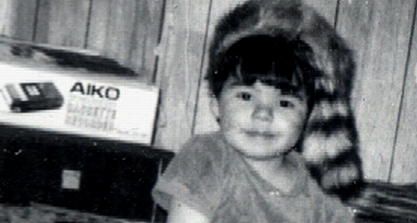Probably one of the earliest occurrences of the phrase "Broken Vulture"; the image is an early variation of one still used in the Bingorage backdrop(as of today and previous ten months, or so).

Two Rivers Gallery poster for Eric Keast's 1997/1998(?) one-man show: Cable and Thong; Connections, at the Minneapolis American Indian Center. Very cool gallery space in a wee dodgy part of town, but we could draw some of the artsy folks from downtown and uptown.

Aboriginal Peoples Choice Music Awards
"The APC Music Awards is the only event where you, the fans, have the opportunity to choose which artist will be honoured in each category. Be a part of Canadian Aboriginal music history."
Voting is enabled until midnight(23:59 pm, Central) October 13,06.
Sobering article @ libcom.org.
From A People's History Of The United States - Howard Zinn:
Total control led to total cruelty. The Spaniards "thought nothing of knifing Indians by tens and twenties and of cutting slices off them to test the sharpness of their blades." Las Casas tells how "two of these so-called Christians met two Indian boys one day, each carrying a parrot; they took the parrots and for fun beheaded the boys."
The Indians' attempts to defend themselves failed. And when they ran off into the hills they were found and killed. So, Las Casas reports, "they suffered and died in the mines and other labors in desperate silence, knowing not a soul in the world to whom they could turn for help."...
When he arrived on Hispaniola in 1508, Las Casas says, "there were 60,000 people living on this island, including the Indians; so that from 1494 to 1508, over three million people had perished from war, slavery, and the mines. Who in future generations will believe this? I myself writing it as a knowledgeable eyewitness can hardly believe it...."
Thus began the history, five hundred years ago, of the European invasion of the Indian settlements in the Americas. That beginning, when you read Las Casas-even if his figures are exaggerations (were there 3 million Indians to begin with, as he says, or less than a million, as some historians have calculated, or 8 million as others now believe?)-is conquest, slavery, death. When we read the history books given to children in the United States, it all starts with heroic adventure-there is no bloodshed-and Columbus Day is a celebration.
Past the elementary and high schools, there are only occasional hints of something else. Samuel Eliot Morison, the Harvard historian, was the most distinguished writer on Columbus, the author of a multivolume biography, and was himself a sailor who retraced Columbus's route across the Atlantic. In his popular book Christopher Columbus, Mariner, written in 1954, he tells about the enslavement and the killing: "The cruel policy initiated by Columbus and pursued by his successors resulted in complete genocide..."
Merry columbus day.
Millefiori-style fridge-magnet faces, in polymer clay.

I discovered this puppet-maker's blog, reading through a papier-mache group newsletter. Some great works to look at, as well as tips and tricks for the crafter. Creaturiste.
Tags:


2 comments:
you ever read almanac of the dead by whats her name? after quoting zinn you should maybe quote her. lady makes a lot of sense for a fiction writer. oh yeah, her name is leslie marmon silko. almanac of the dead. one of the greatest pieces of american fiction(?) ever.
Agreed... good book; I'm pretty sure that you turned me on to it, mega years ago. Must re-read.
Post a Comment